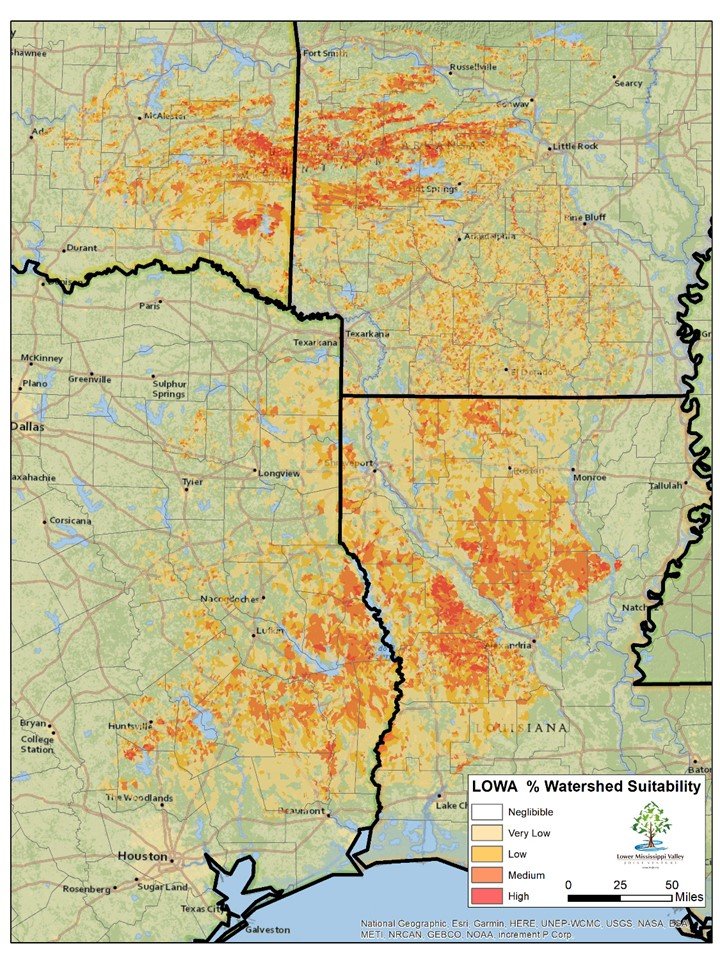Landbird Plans
The Mississippi Alluvial Valley (MAV) and the West Gulf Coastal Plain/Ouachitas (WGCPO) regions provide extremely important habitat to forest-breeding landbirds. The LMVJV partnership provides science-based guidance regarding conservation of these species and habitats through quantitative population & habitat objectives (see below), decision support models (such as those for forest protection priorities, forest restoration priorities, or open pine management) and descriptions of desired forest conditions (stand scale & landscape scale) for wildlife.
Landbird Conservation Plans are “stepped down” plans for each bird conservation region in North America. These plans are generally developed following guidelines for establishing conservation priorities and objectives defined in the Partners in Flight (PIF) landbird conservation plan for the U.S. and Canada.
Mississippi Alluvial Valley
Forest breeding species are one of the most important components of the Mississippi Alluvial Valley (MAV) avifauna, despite the loss of nearly 80% of the forested wetlands in this region. At least 70 species occur in bottomland hardwoods as a primary habitat. Almost 30% of the breeding populations of Prothonotary Warbler are found within the Mississippi Alluvial Valley. Other typical species of bottomland hardwood forests include Northern Parula, Swainson's Warbler, Red-shouldered Hawk, and Red-headed Woodpecker.
Partners have developed spatially explicit decision support models, based on breeding ecology of priority species, that prioritize forest restoration to reduce forest fragmentation, increase the area of forest core, and strategically protect existing forest habitat. Further, the LMVJV’s Desired Forest Conditions for Wildlife metrics provide managers with guidance regarding key stand- and landscape-scale characteristics for increased habitat quality.
Habitat & Population Objectives
These objectives are based upon the data & analyses within the following peer-reviewed manuscript:
Forest Area to Support Landbird Population Goals for the Mississippi Alluvial Valley, Twedt & Mini (2021)
Summary Document - MAV Forest Breeding Bird Planning
West Gulf Coastal Plain/Ouachitas
The West Gulf Coastal Plain/Ouachitas (WGCPO) Bird Conservation Region encompasses 52 million acres of northwest Louisiana, southwest Arkansas, easternmost Texas, and the southeast corner of Oklahoma. The WGCPO is a diverse mix of habitats, including pine forest and bottomland hardwood forest – both of which are priority habitats for the Lower Mississippi Valley Joint Venture.
Pine forest habitat represents the majority of habitat in the WGCPO. The ideal condition of pine forest in the WGCPO for birds is characterized by and open canopy above, and herbaceous ground and sparse mid-story layers that are maintained with periodic fires. With fire suppression and conversion of native pine forest to pine plantations planted at high stem densities, many of the bird species dependent upon this habitat have markedly declined. Priority bird species include Northern Bobwhite, Brown-headed Nuthatch, Bachman’s Sparrow, and Red-Cockaded Woodpecker, among others.
Bottomland hardwood forest and associated riparian areas occur along the Arkansas, Ouachita, Sabine, Neches, and Red Rivers as well as other river flood plains. The primary threats to forested wetlands in the region are reservoirs and conversion of hardwood stands to pine plantation, pasture, or other land uses. Bottomland hardwood forests and riparian areas represent a unique and imperiled habitat in the WGCPO that supports such area-sensitive breeding birds as Acadian Flycatcher, Kentucky Warbler, Louisiana Waterthrush, Prothonotary Warbler, and Red-Shouldered Hawk.
The Joint Venture partnership has undertaken planning efforts for both of these habitats.
Forested Wetland
West Gulf Coastal Plain and Ouachitas Forested Wetland Plan, Version 1.1
WGCPO Forested Wetland Decision Support Model
North American Landbird Conservation Plan
This plan is the parent plan of regional landbird plans in North America. The North American Landbird Conservation Plan aims to keep common birds common. It assesses continental bird populations and makes recommendations to address continental threats, reverse long-term population declines, and prevent landbirds from becoming at-risk. For more information, visit Partners in Flight.







